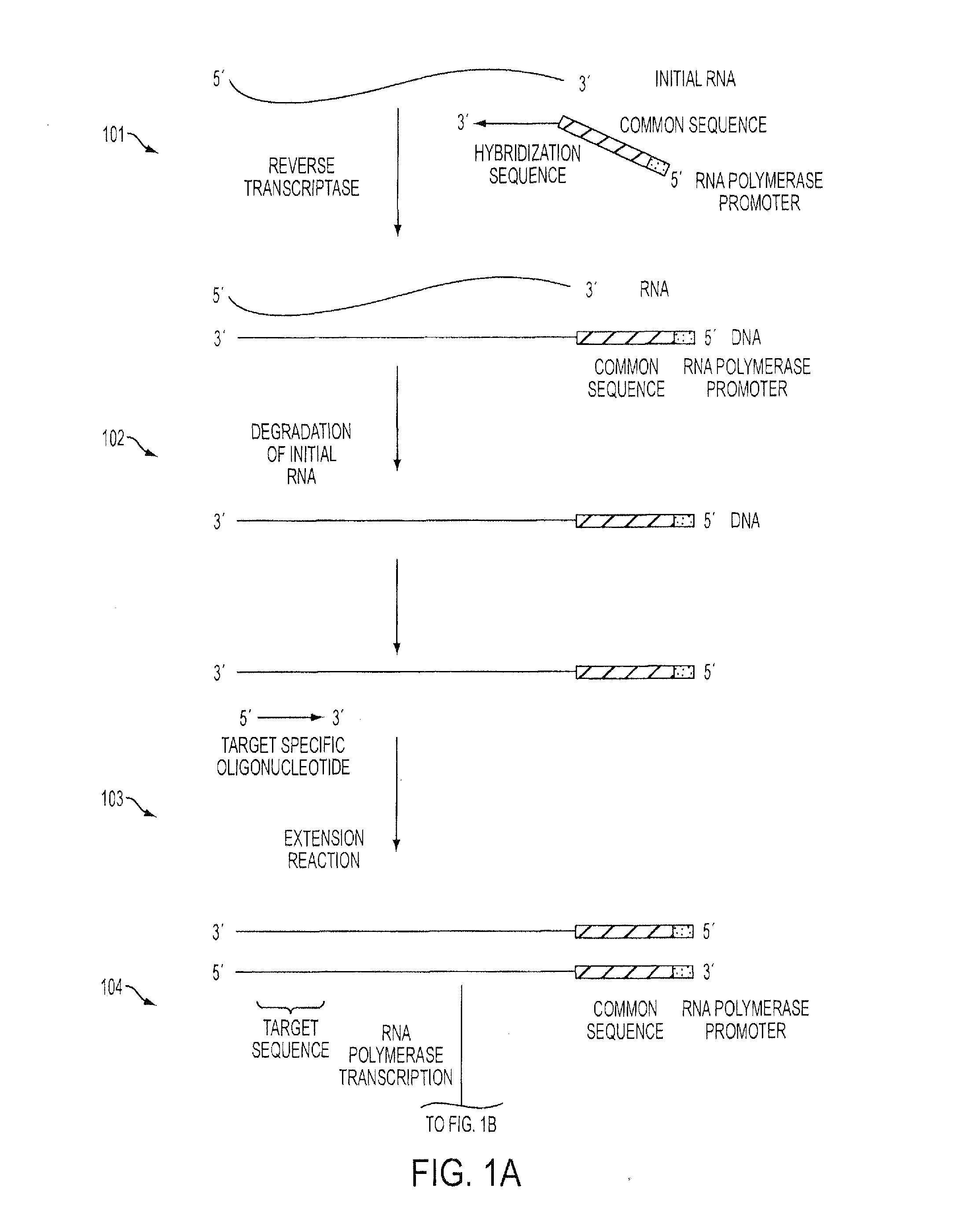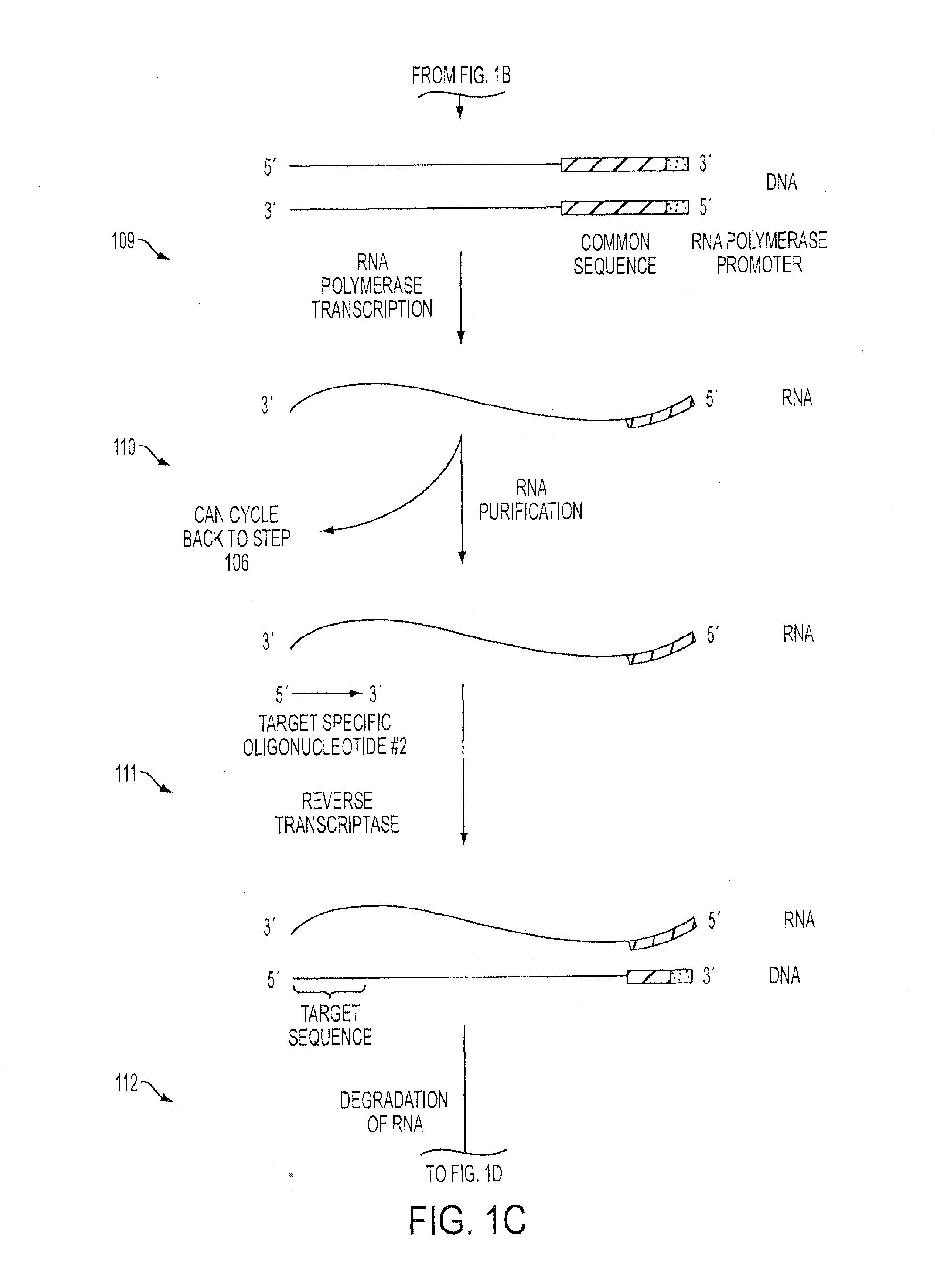Isothermal Methods and Related Compositions for Preparing Nucleic Acids
a technology of isothermal methods and compositions, applied in combinational chemistry, biochemistry apparatus and processes, library member identification, etc., can solve the problems of ineffective methods for obtaining rapid and accurate sequencing, limited types of genetic events captured using existing methods, and long and inefficient methods. achieve the effect of rapid and accurate sequencing results
- Summary
- Abstract
- Description
- Claims
- Application Information
AI Technical Summary
Benefits of technology
Problems solved by technology
Method used
Image
Examples
example 1
An Isothermal Method Using Reverse Transcriptase with Tagged Randomers and Targeted Second Strand Oligonucleotides to Amplify 3′Fusion Events
Amplification #1
[0084]As a first step towards amplifying a 3′fusion event with an unknown fusion partner, a first amplification reaction was performed using RNA obtained from a formalin fixed tissue sample.
[0085]The following reaction was assembled with reaction buffer at room temperature:[0086]1 μL purified RNA (50 ng)[0087]1 μL 3 μM V3-FGFR GSP1[0088]1 μL 5 μM T7-N9 Randomer[0089]2 μL dH2O
[0090]The reaction was mixed gently, centrifuged for a few seconds and transferred to a thermal cycler where it was incubated at 65° C. for 2 minutes followed by 41° C. for 11.5 minutes.
[0091]In some embodiments, an enzyme mix is used. In some embodiments, the enzyme mix is lyophilized and reconstituted prior to use. In some embodiments, the enzyme mix comprises 2, 3 or more enzymes. In some embodiments, the enzyme mix further comprises a high molecular weig...
example 2
An Isothermal Method Using Reverse Transcriptase with Tagged Randomers and Targeted Second Strand Oligonucleotides to Amplify 5′Fusion Events
Amplification #1
[0121]The first step towards amplifying a genetic locus containing a 5′fusion event with an unknown fusion partner is to perform a reverse transcriptase event on the obtained sample RNA using a target / gene-specific primer(s).
[0122]The following reaction was assembled with reaction buffer at room temperature:[0123]1 μL purified RNA (50 ng)[0124]1 μL 3 μM V3-FGFR GSP1[0125]1 μL 5 μM T7-N9 Randomer[0126]2 μL dH2O
[0127]The reaction was mixed gently, centrifuged for a few seconds and transferred to a thermal cycler where it was incubated at 65° C. for 2 minutes followed by 41° C. for 11.5 minutes.
[0128]During the oligonucleotide-RNA annealing reaction above, the enzyme mix was prepared. The diluent for the lyophilized enzyme mix was thawed, then 30 μL of cold diluent was added to the lyophilized enzyme mix and incubated for 6 minutes...
example 3
An Isothermal Method to Exponentially Amplify Target Sequences Beginning with Genomic DNA
[0157]To prepare target regions of double-stranded genomic DNA for analysis, the DNA was first fragmented to between 100-600 bp in size.
[0158]In order to repair the ends of the fragments, then phosphorylate and adenylate opposing ends, the following reaction was prepared:[0159]10 μL fragmented DNA (50-250 ng)[0160]4 μL end-repair buffer[0161]1 μL end-repair mix[0162]1 μL Taq polymerase (A-tailing)[0163]1 μL 2 mM dNTPs
[0164]The reaction was mixed gently and incubated in a thermal cycler at 12° C. for 15 minutes, 37° C. for 15 minutes, then 72° C. for 15 minutes, followed by 4° C. until proceeding with the next steps.
[0165]During the reaction above, the oligonucleotide adapter sequences containing 5′ RNA polymerase promoter sequences were annealed by mixing equal volumes of each oligonucleotide, heating to 95° C. and allowing to cool to room temperature.
[0166]The following ligation reaction was as...
PUM
| Property | Measurement | Unit |
|---|---|---|
| Degradation properties | aaaaa | aaaaa |
Abstract
Description
Claims
Application Information
 Login to View More
Login to View More - R&D
- Intellectual Property
- Life Sciences
- Materials
- Tech Scout
- Unparalleled Data Quality
- Higher Quality Content
- 60% Fewer Hallucinations
Browse by: Latest US Patents, China's latest patents, Technical Efficacy Thesaurus, Application Domain, Technology Topic, Popular Technical Reports.
© 2025 PatSnap. All rights reserved.Legal|Privacy policy|Modern Slavery Act Transparency Statement|Sitemap|About US| Contact US: help@patsnap.com



